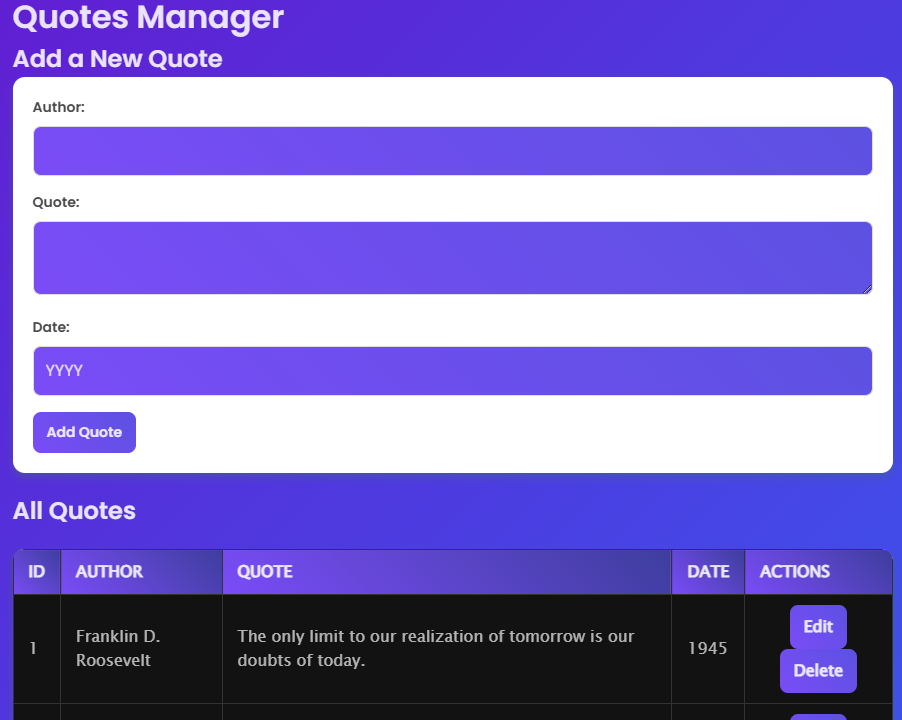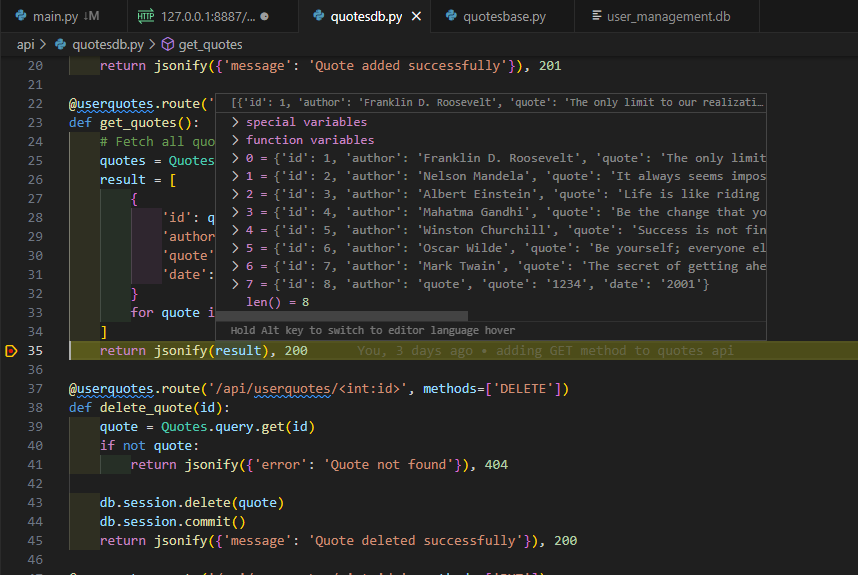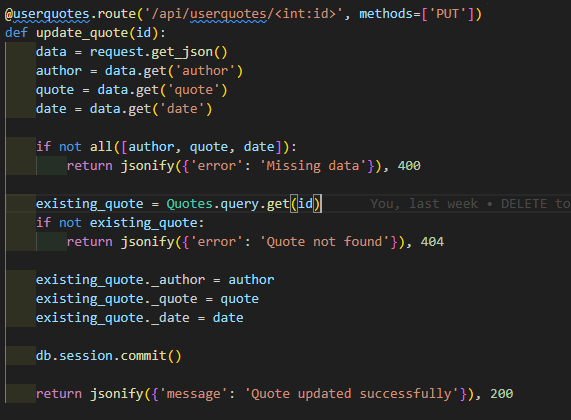Study Buddy
StudyBuddy is an interactive platform built to support students throughout their academic journey. Whether you’re mastering math, exploring science, diving into history, or studying any other subject, StudyBuddy is here to help you excel. Our mission is to make learning enjoyable, engaging, and effective. With a wide range of tools at your disposal, StudyBuddy provides a well-rounded study experience.
Quote Manager
The Quote Manager feature allows users to store, edit, and delete quotes in a database. It provides a user-friendly interface with a dynamic table displaying quotes, authors, and dates. Every row in the datatable includes a quote with its respective author and date.
The backend API handles all interactions using GET, POST, PUT, and DELETE methods, ensuring seamless data management.
JavaScript Methods in the Quote Management App
This script manages user quotes through CRUD (Create, Read, Update, Delete) operations using a REST API.
Data is sent and received in JSON (JavaScript Object Notation) format.
1. fetchQuotes()
- Purpose: Fetches and displays quotes from the API.
- Process:
- Sends a
GETrequest toAPI_URL. - Parses the JSON response containing an array of quotes.
- Iterates through the quotes and dynamically updates the HTML table.
- Each row includes an “Edit” and “Delete” button.
- Sends a
2. addQuote(event)
- Purpose: Adds a new quote to the database.
- Process:
- Prevents form default submission with
event.preventDefault(). - Reads input values (author, quote, date).
- Converts data into a JSON object and sends a
POSTrequest. - If successful, the new quote is added, and the form is reset.
- Prevents form default submission with
3. deleteQuote(id)
- Purpose: Deletes a quote based on its ID.
- Process:
- Sends a
DELETErequest to remove the quote. - If successful, the user is alerted, and
fetchQuotes()refreshes the table.
- Sends a
4. editQuote(id, currentAuthor, currentQuote, currentDate)
- Purpose: Prepares the form to edit an existing quote.
- Process:
- Switches from “Add” mode to “Edit” mode.
- Pre-fills the form fields with the current quote’s data.
- Overrides form submission to send an updated JSON object via a
PUTrequest.
5. cancelEdit()
- Purpose: Cancels the edit mode and returns to the add form.
- Process:
- Hides the edit form and shows the add form.
- Resets the edit form fields.
6. init()
- Purpose: Initializes the app on page load.
- Process:
- Attaches the
addQuote()function to the form’s submit event. - Calls
fetchQuotes()to load existing quotes.
- Attaches the
7. DOMContentLoaded Event Listener
- Ensures
init()runs after the document is fully loaded.
JSON Usage in This Script
- Sending Data: Quotes are converted into a JSON object (
JSON.stringify({ author, quote, date })) before sending viaPOSTorPUTrequests. - Receiving Data: The server response is parsed as JSON (
await response.json()) to dynamically update the UI. - API Communication: The script uses fetch API to interact with a backend that processes and stores JSON-formatted quotes.
API for Quote Management
This API handles CRUD (Create, Read, Update, Delete) operations for user quotes.
Data is exchanged in JSON format, and jsonify is used to return JSON responses.
1. @userquotes.route('/api/userquotes', methods=['POST'])
- Purpose: Adds a new quote to the database.
- Process:
- Retrieves JSON data from the request using
request.get_json(). - Extracts
author,quote, anddatefields. - Returns an error if any required field is missing (
400 Bad Request). - Creates a new
Quotesobject and adds it to the database. - Uses
jsonify()to return a success message in JSON format (201 Created).
- Retrieves JSON data from the request using
2. @userquotes.route('/api/userquotes', methods=['GET'])
- Purpose: Retrieves all quotes from the database.
- Process:
- Queries all quotes from the
Quotestable. - Converts each quote object into a JSON-compatible dictionary.
- Uses
jsonify()to return a list of dictionaries with the id, quote, author, and date (200 OK).
- Queries all quotes from the
3. @userquotes.route('/api/userquotes/<int:id>', methods=['DELETE'])
- Purpose: Deletes a quote by its ID.
- Process:
- Searches for the quote using
Quotes.query.get(id). - If the quote doesn’t exist, returns a JSON error (
404 Not Found). - If found, deletes it from the database and commits changes.
- Uses
jsonify()to return a success message (200 OK).
- Searches for the quote using
4. @userquotes.route('/api/userquotes/<int:id>', methods=['PUT'])
- Purpose: Updates an existing quote by ID.
- Process:
- Retrieves JSON data using
request.get_json(). - Extracts
author,quote, anddatefields. - If any field is missing, returns a JSON error (
400 Bad Request). - Searches for the existing quote in the database.
- If the quote is not found, returns a JSON error (
404 Not Found). - Updates the quote’s fields and commits the changes.
- Uses
jsonify()to return a success message (200 OK).
- Retrieves JSON data using
Backend: Database Model and Initialization
The backend uses Flask-SQLAlchemy to define and manage a database table for storing quotes. The Quotes class represents a database model, and the initquotes() function initializes the table with sample data.
1. Quotes Model
The Quotes class is a database table for storing user quotes. It has the following attributes:
id: A unique identifier (Primary Key)._author: The name of the person who said the quote._quote: The actual quote text._date: The year the quote was said.
The model also includes methods for CRUD (Create, Read, Update, Delete) operations, making it easy to manage quotes.
2. Database Initialization with initquotes()
The function initquotes() ensures that the database is properly set up and pre-populated with quotes.
How It Works
- Calls
db.create_all()to create theuser_quotestable if it doesn’t exist. - Adds predefined quotes (e.g., from Albert Einstein, Gandhi).
- Uses
.create()method to insert them into the database. - Handles errors like duplicate entries using
IntegrityError.
🚀 Sequencing, Selection, and Iteration in the Quotes Class
Sequencing
🔹 Example from Quotes Class:
def create(self):
try:
db.session.add(self) # Step 1: Add the quote to the database
db.session.commit() # Step 2: Commit the changes
except Exception as e:
db.session.rollback() # Step 3: Rollback if there's an error
raise e
@staticmethod
Selection
🔹 Example from Quotes Class:
def restore(data):
for sbuser_data in data:
author = sbuser_data.get("author", None)
sbuser = Quotes.query.filter_by(_author=author).first()
if sbuser: # Selection: If the quote exists, update it
sbuser.update(sbuser_data)
else: # Otherwise, create a new quote entry
sbuser = Quotes(**sbuser_data)
sbuser.update(sbuser_data)
sbuser.create()
Iteration
🔹 Example from Quotes Class:
@staticmethod
def restore(data):
for sbuser_data in data: # Iterating through each quote in the data
author = sbuser_data.get("author", None)
sbuser = Quotes.query.filter_by(_author=author).first()
if sbuser:
sbuser.update(sbuser_data)
else:
sbuser = Quotes(**sbuser_data)
sbuser.update(sbuser_data)
sbuser.create()
🎯 How This Connects to CollegeBoard AP CSP Big Idea 1 (Creative Development)
🔹 Big Idea 1: Creative Development focuses on:
✔️ The design and implementation of programs. ✔️ Using sequencing, selection, and iteration to develop functional solutions. ✔️ Collaboration and problem-solving through structured programming.
🔹 How the Quotes Class Fulfills Big Idea 1:
Creative Development
- The restore() function is designed to efficiently process multiple quotes while avoiding duplicates.
- Uses logical selection (if-else) and iteration (loops) to manage database operations.
Algorithm Design
- The combination of sequencing, selection, and iteration ensures smooth execution.
- The if condition prevents duplicate entries, making the program efficient.
Data Processing
- The loop iterates over a dataset of quotes, making the function scalable.
- The selection logic ensures that only necessary updates are made.



